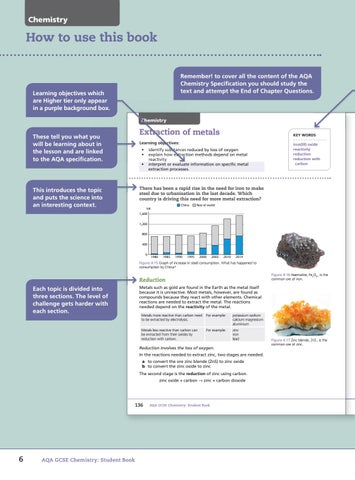Chemistry
How to use this book Remember! to cover all the content of the AQA Chemistry Specification you should study the text and attempt the End of Chapter Questions.
Learning objectives which are Higher tier only appear in a purple background box. Chemistry
Extraction of metals
These tell you what you will be learning about in the lesson and are linked to the AQA specification.
KEY WORDS
Learning objectives: s¬ identify substances reduced by loss of oxygen s¬ explain how extraction methods depend on metal reactivity s¬ interpret or evaluate information on specific metal extraction processes.
iron(III) oxide reactivity reduction reduction with carbon
There has been a rapid rise in the need for iron to make steel due to urbanisation in the last decade. Which country is driving this need for more metal extraction?
This introduces the topic and puts the science into an interesting context.
China
Rest of world
Mt 1,600 1,200 800 400 0
1980
1985
1990
1995
2000
2005
2010
2014
Figure 4.15 Graph of increase in steel consumption. What has happened to consumption by China? Figure 4.16 Haematite, Fe2O3 , is the common ore of iron.
Reduction Metals such as gold are found in the Earth as the metal itself because it is unreactive. Most metals, however, are found as compounds because they react with other elements. Chemical reactions are needed to extract the metal. The reactions needed depend on the reactivity of the metal.
Each topic is divided into three sections. The level of challenge gets harder with each section.
Metals more reactive than carbon need to be extracted by electrolysis.
For example:
potassium sodium calcium magnesium aluminium
Metals less reactive than carbon can be extracted from their oxides by reduction with carbon.
For example:
zinc iron lead
Figure 4.17 Zinc blende, ZnS , is the common ore of zinc.
Reduction involves the loss of oxygen. In the reactions needed to extract zinc, two stages are needed. a to convert the ore zinc blende (ZnS) to zinc oxide b to convert the zinc oxide to zinc The second stage is the reduction of zinc using carbon. zinc oxide + carbon → zinc + carbon dioxide
136
6
AQA GCSE Chemistry: Student Book
AQA GCSE Chemistry: Student Book
58767_P001_011.indd 6
5/24/16 3:22 PM
